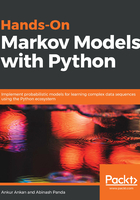
Random processes
In the previous section, we discussed random variables that are able to mathematically represent the outcomes of a single random phenomenon. But what if we want to represent these random events over some period of time or the length of an experiment? For example, let's say we want to represent the stock prices for a whole day at intervals of every one hour, or we want to represent the height of a ball at intervals of every one second after being dropped from some height in a vacuum. For such situations, we would need a set of random variables, each of which will represent the outcome at the given instance of time. These sets of random variables that represent random variables over a period of time are also known as random processes. It is worth noting that the domains of all these random variables are the same. Therefore, we can also think of the process as just changing the states.
Now let's discuss the previous two examples in more detail. Starting with the example of dropping the ball from a height in a vacuum, if we know the exact value of gravity and the height from which the ball is being dropped, we will be able to determine the exact location of the ball at every interval of one second using Newton's laws of motion.
Such random processes, in which we can deterministically find the state of each random variable given the initial conditions (in this case, dropping the ball, zero initial velocity) and the parameters of the system (in this case, the value of gravity), are known as deterministic random processes (commonly called deterministic processes).
Now let's go to the second example; representing the stock price over time. In this case, even if we know the current price and the exact probability distribution of the price at the next one hour mark, we won't be able to deterministically compute the value. These random processes, in which we can't determine the state of a process, even if we are given the initial conditions and all the parameters of the system, are known as stochastic random processes (commonly called processes). A very good way of understanding or getting a feel for a stochastic process is to think of it as being the opposite of a deterministic process.